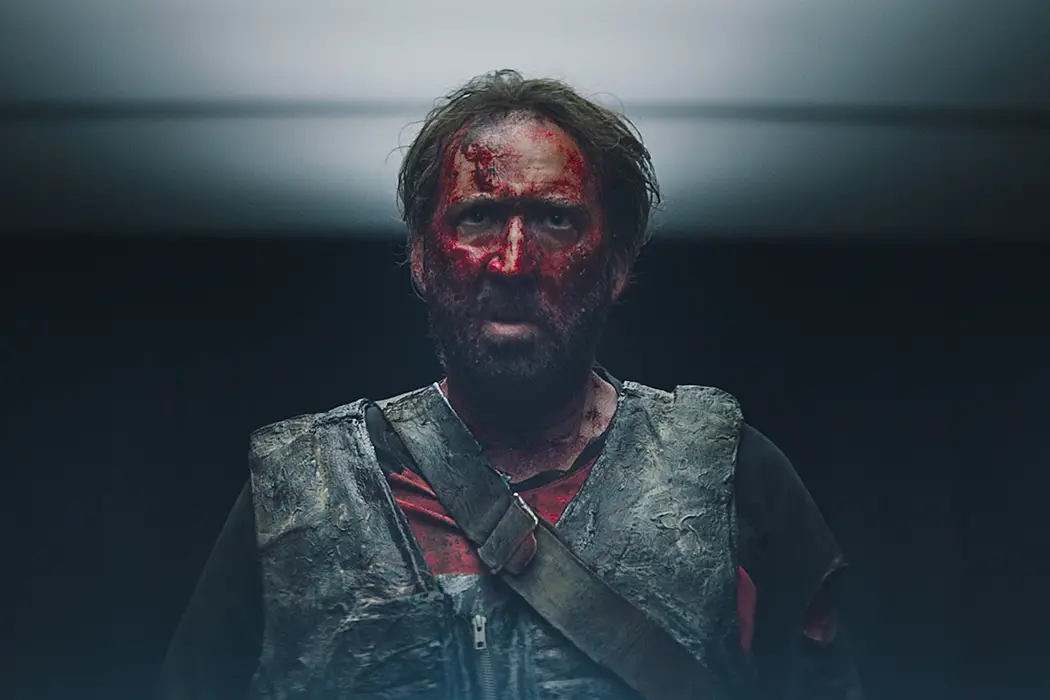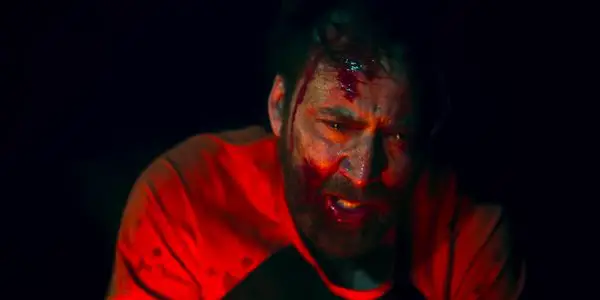MANDY: Hallucinatory Nightmare Is The Year’s Wildest Trip

I'm a student at the University of North Carolina at…
I didn’t actually enjoy Panos Cosmatos‘ Beyond the Black Rainbow, but I sure am glad I watched it before diving headfirst into his latest outing. The budding auteur’s debut feature asks a bit too much of its viewers, demanding total patience as it delivers a myriad of strange occurrences within the confines of a 1980s experimental institution. But its self-indulgence grows tiresome, sinking the film into an abyss of abstract interludes and unabashed weirdness. Is it ambitious and creepy? Absolutely. Satisfying? Not quite.
Mandy, the director’s follow up to Black Rainbow and a Sundance sensation, continues to establish Cosmatos‘ many predilections as a visual stylist and storyteller, albeit in a significantly more successful package. Much has been made of the shocking carnage and Nicolas Cage‘s outrageous performance, but Mandy is still very much a showcase for the unique mind of Panos Cosmatos.
Yes, the film is esoteric and deliberate, but it just flatout works, due mainly to the presence of a pair of strong performances and a cohesive thematic center. And then there’s the savage violence, which serves as the sweet, bloody cherry on top. Mandy is so thoroughly staggering as an acid-laced journey into the realm of the nightmarish that I was partially convinced the film had administered some kind of drug treatment on my brain, a treatment that kicked in the moment I pressed play.
It’s that kind of movie. And I haven’t even mentioned the subhuman creatures of the night or the chainsaw duel yet.
Revenge & Fanaticism In The American Wilderness
It’s 1983 A.D. in the Shadow Mountains, and Red (Cage) and Mandy (Andrea Riseborough) are as happy as ever. Red is a lumberjack for a local company, while Mandy spends her days reading and drawing gorgeous works of art, working at a tiny store to help pay the bills. This is Ronald Reagan’s America, as indicated by his speech on the radio, proclaiming the spiritual awakening that led to the reclamation of traditional American values.
But for Red and Mandy, the outside world is irrelevant. They spend their days together in an Eden-like utopia, watching TV, recalling stories from their traumatic pasts, and sharing their favorite planets with one another.

Enter Jeremiah Sand (Linus Roache). He’s the leader of Children of the New Dawn, a cult of so-called “Jesus freaks” who wander the wilderness in a dingy old van. Jeremiah spots Mandy while she’s walking through the blood red woods, and he’s instantly transfixed by her face, citing a connection between them. He calls upon his followers to find Mandy, and with the help of a gang of monstrous, shadowy bikers (known as the Black Skulls), the cult accomplishes that task.
From there, things go south rather quickly. A horrifying tragedy occurs, and Red is left for dead at his simple abode in the forest. But if you thought Red wouldn’t fight back, you’re solely mistaken. This crime against him and his true love awakens something in him, and Jeremiah will be sorry that he ever messed with Mandy. With the help of a fellow loner (Bill Duke), Red gears up for the fight of a lifetime, one that might annihilate his sanity. But no matter. It’s hunting season, and he’s coming for everyone, especially Jeremiah.
Awe-Inspiring Visuals, Deliberate Pacing
Cosmatos loves to luxuriate in his ethereal composition, transporting his audience to a grounded world turned upside down. Each frame is a painting, crafted with meticulous love and care, and many are simply gorgeous to behold. This is a moody and atmospheric experience, content to serve as a rich, kaleidoscopic display of horror imagery and uncompromising beauty.
The downside for some viewers will be the film’s general lack of urgency, as it’s just as slow as you’ve probably heard. Cosmatos loves to extend sequences beyond what many filmmakers would see as their natural conclusion, focusing on little things that seem vaguely inconsequential or superfluous.

But if you’re paying close attention to what’s going on during even the most seemingly banal and quiet of moments, you’ll find that these minor grace notes make up for the lack of conventional exposition. The devil’s in the details here, and Cosmatos and cowriter Aaron Stewart-Ahn find some remarkable ways to establish these characters and this world in the early goings.
The love that Red and Mandy have for each other is palpable, to the extent that it even feels like Cage and Riseborough improvised their most gentle interactions. There’s an understated poignancy to seeing how these two outsiders have found solace in each other, which rightly becomes the core thrust of the film. Riseborough is magnetic and tender, and Cage is just as good when he’s being a caring partner as he is when he’s wielding a weapon of mass destruction.
Of course, the detailed approach expands beyond the core relationship. The inner workings of the film’s creepy cult are revealed rather early, and it’s terrifying to see how Roache‘s brilliant Jeremiah commands power and distributes trust. And while I still don’t understand Cosmatos‘ love for the early 1980s, it’s a clever move to situate a story of the religious right gone wild during the early days of the Reagan era.
Psychedelic Violence On A Voyage To Hell
Still, Mandy‘s most impressive feat is its ability to feel like a bonkers trip gone very wrong. So many movies claim to be a psychedelic journey, but so few actually use that for any kind of disturbing or harrowing effect. Usually, that haze is used solely for comedic purposes. Or if a director really does go for the trippy approach, they keep things recognizable enough to maintain some semblance of realism.
This is a different story.

There is a point in Mandy where I started to wonder if anything was still rooted in reality. Things get so mind bending and creepy that it all feels like an ambiguous nightmare. Seriously, the experience of watching this movie is the closest I’ll ever get to taking psychedelics.
To go along with the general unease of the film, Cosmatos stages some cathartic bloodshed, sparing no expense in the gore department. The pace remains languid and precise, but the violence is relentless and gruesome, a spectacle of blood, dirt, and the most ridiculous weapons imaginable. It’s suitably nutty, and it’s likely to give the film a level of notoriety for years to come.
Mandy: Conclusion
Did I mention that Mandy is also really funny? Perhaps the most unexpected delight of this nightmarish mindbender is its strain of humor, both playful and darkly incisive. In between grisly murders, Mandy shifts tones completely; one minute you’re watching a cult member play with a car window, and the next you’re seeing Nicolas Cage stage one of the greatest cinematic breakdowns of all time. This movie has it all, and it’s overwhelming to see Cosmatos put the pieces together. If you want an even more specific idea of what you’re in for, here’s one of my favorite exchanges:
“So whatchu hunting?”
“Jesus freaks.”
“Didn’t know they were in season.”
This movie is something else. Prepare yourselves.
What did you think of Mandy? What’s your favorite Nicolas Cage performance? Let us know in the comments below!
Mandy was released on VOD and in select theaters in the U.S. on September 14. For full international release information, click here.
Does content like this matter to you?
Become a Member and support film journalism. Unlock access to all of Film Inquiry`s great articles. Join a community of like-minded readers who are passionate about cinema - get access to our private members Network, give back to independent filmmakers, and more.
I'm a student at the University of North Carolina at Chapel Hill. For 8 years, I've edited the blog Martin on Movies. This is where I review new releases, cover new trailers, and discuss important news in the entertainment industry. Some of my favorite movies- Casablanca, Inception, Singin' in the Rain, 2001: A Space Odyssey, The Wolf of Wall Street, The Nice Guys, La La Land, Airplane!, Skyfall, Raiders of the Lost Ark. You can find my other reviews and articles at Martin on Movies (http://martinonmovies.blogspot.com/).













